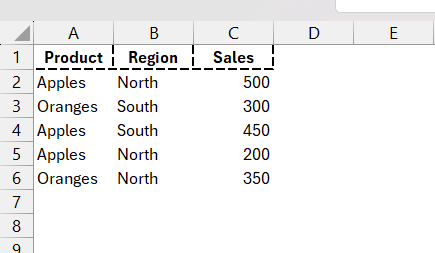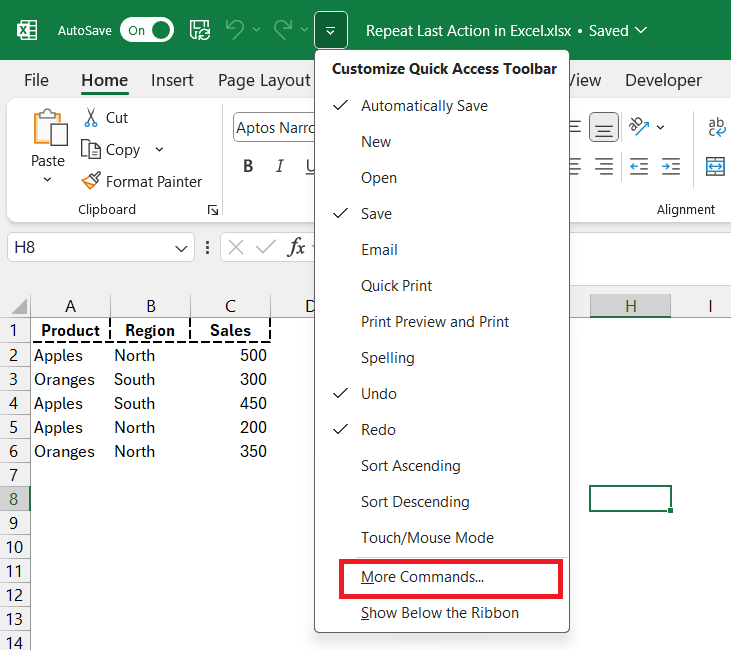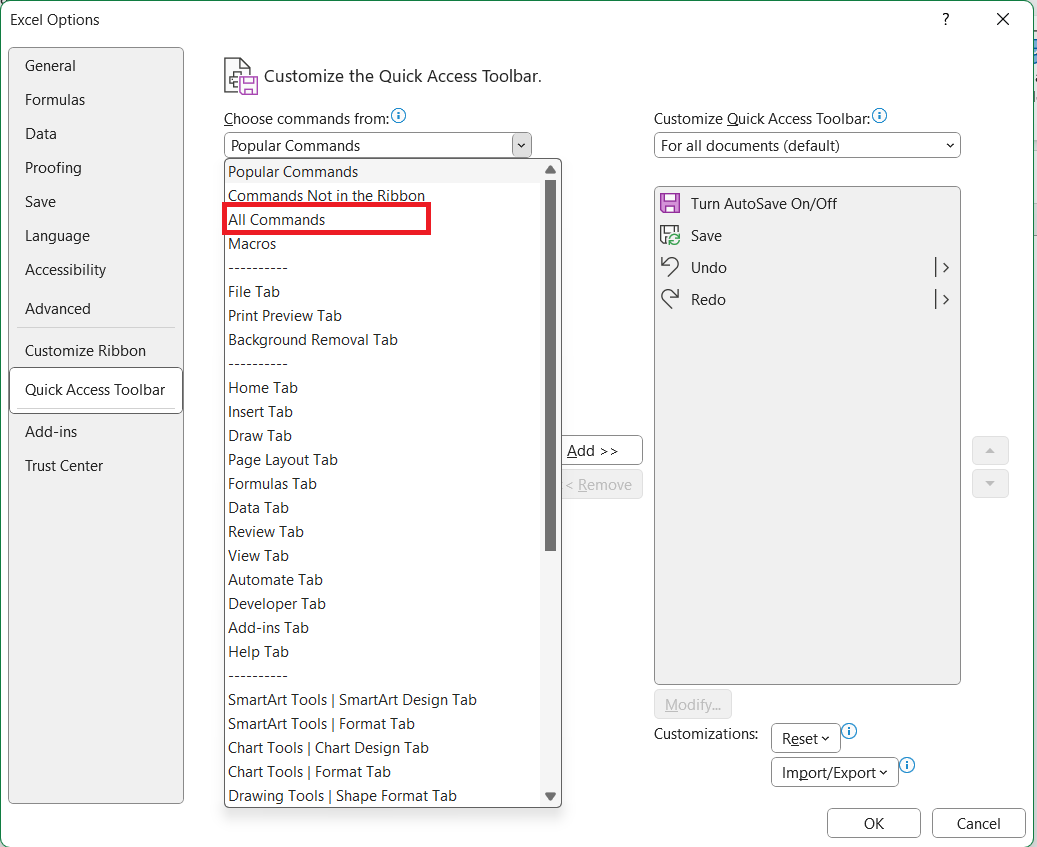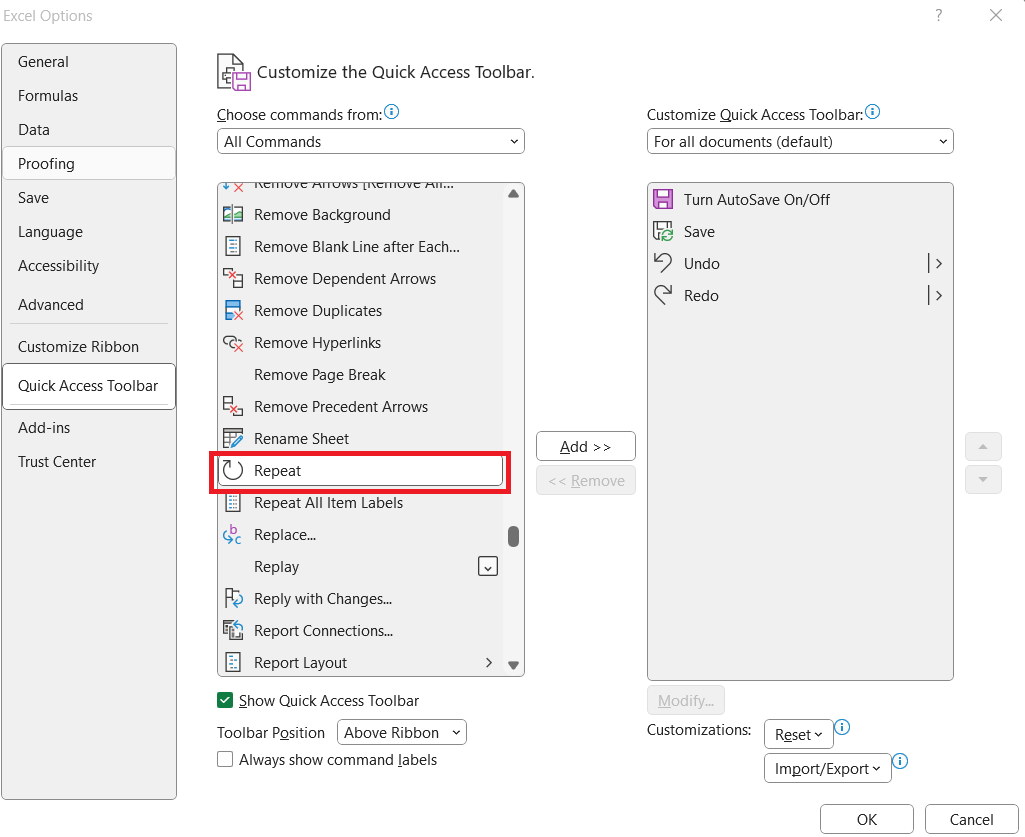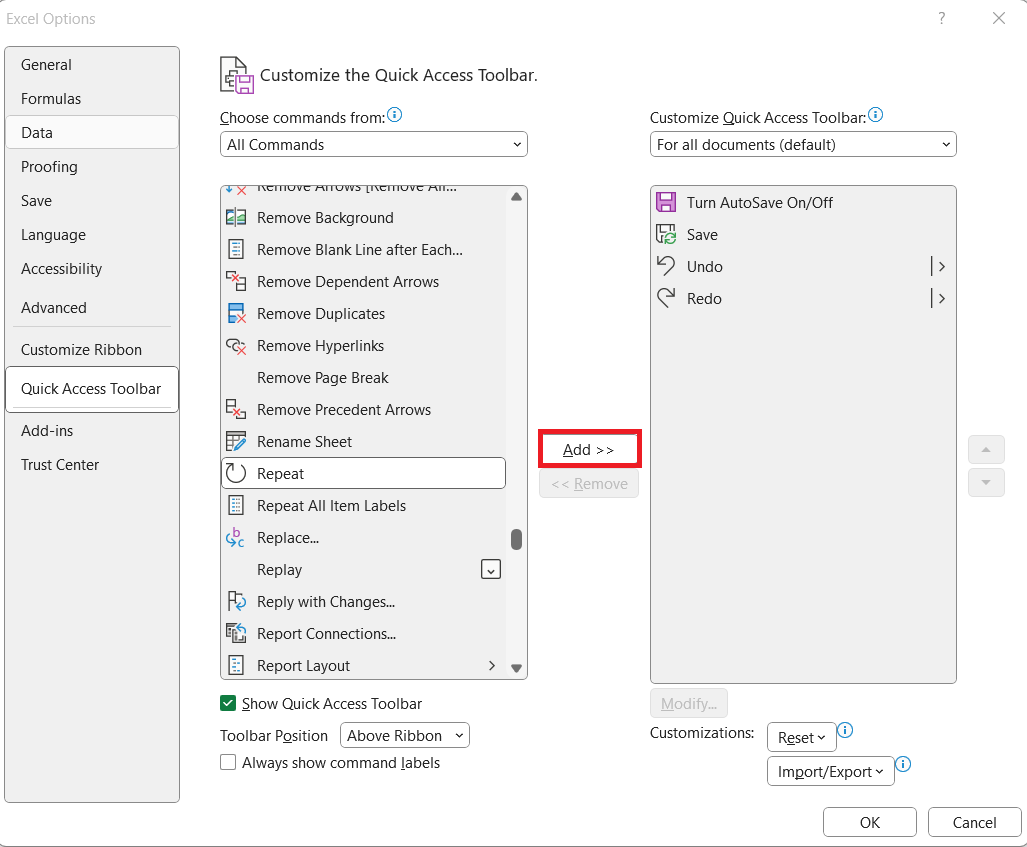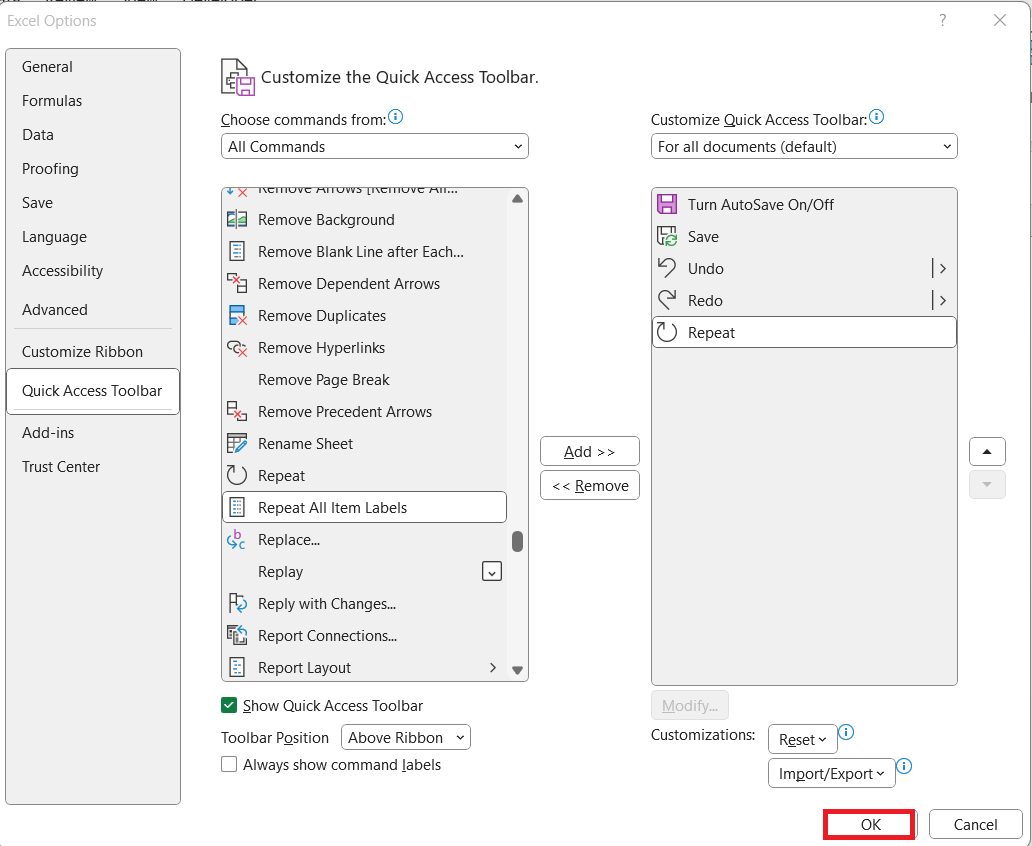When working in Excel, it can be a huge time-saver to repeat the last action you’ve just performed. Whether it’s formatting a cell, inserting a row, or applying a specific function, knowing how to do this efficiently with just a few clicks or keystrokes can streamline your workflow and boost productivity.
Key Takeaways:
- F4 Shortcut Efficiency: Pressing F4 repeats your last action, saving time on repetitive tasks like formatting and inserting rows.
- Control + Y Flexibility: Control + Y functions as both a redo and repeat command, depending on the context.
- Customizing the Quick Access Toolbar: Adding the Repeat command to the Quick Access Toolbar offers quick access without keyboard shortcuts.
- Consistency Across Large Datasets: The Repeat function helps maintain formatting consistency across multiple cells or rows, especially in large datasets.
- Time-Saving Power Tool: Using the Repeat feature enhances productivity by reducing manual repetition, streamlining workflow.
Table of Contents
Excel Power Users: Master the Repeat Last Action Shortcut!
The Golden Key to Efficiency
As an ardent Excel user, I’ve found that mastering certain shortcuts is akin to discovering a golden key to efficiency. One of the most powerful of these is the “Repeat Last Action” shortcut. It allows us to dramatically reduce the repetition of tasks, thereby mitigating stress and potentially decreasing over time.
In my own experience, employing this shortcut has not only saved me invaluable time but has also exponentially increased my productivity—a factor that can substantially boost the likelihood of promotions or salary increments.
Delving into the “Repeat Last Action” Feature
A Quick Overview of the Action-Replication Magic
The art of replicating actions in Excel can feel almost magical. Here’s how it goes: you perform a particular action, say formatting a cell with a certain color or adjusting a row height. Then, to apply that exact same action elsewhere, you can use the “Repeat Last Action” shortcut instead of manually doing it all over again.
This command is like having a helpful assistant duplicating your efforts wherever needed, which is incredibly useful for large datasets.
Using this action, you easily maintain consistency across your spreadsheets, ensuring that every detail matches up according to your initial action. It’s particularly handy for formatting, inserting rows or columns, and even copying formulas across cells. With the right knowledge, the action-replication feature can feel like a well-guarded secret, turning you into an Excel wizard among mere mortals.
When and Why You Should Use Repeat Command
The Repeat command comes into its own when I’m working with extensive data sets or when I need to apply the same format across multiple cells or worksheets. Say I’m putting together a report and I need all the title rows to have the same background color, font size, and border style. Instead of formatting each row individually, I use the Repeat command and watch as the work is done in a blink.
Why should we use it? Quite simply, it’s a time-saver that keeps our work consistent and professional-looking. There’s also the less tangible but equally important satisfaction that comes from efficient work — using the Repeat command just feels good, knowing we’re working smart, not hard.
Unveiling the Shortcut King: How to Reissue Commands with Ease
The Evergreen F4: Your Repeat Last Action Ally
The F4 key has become my steadfast ally in Excel. It’s the trusty sidekick waiting quietly on the keyboard, ready to spring into action with just a tap. The way it works is brilliantly straightforward: execute any action once, be it applying a formula or setting up a data format, and then press F4.
The magic happens as Excel re-enacts that last manipulation to the new selection without missing a beat.
For instance, I recently styled a cell border which I then needed to replicate across 20 other cells. Instead of going through the steps for each one, I simply clicked on each cell and pressed F4, watching the borders appear instantly.
Its effectiveness multiplies when you’re dealing with repetitive tasks which, in the realm of Excel, is a common occurrence.
Control + Y Chronicles: Another Path to Repetition
While familiar with the trusty F4, I’ve also come across the Control + Y shortcut, which stands as an alternative path to repeating your last action. On Windows, Control + Y can do much of what F4 does, but I’ve noticed that it’s more commonly associated with redoing the last undone action.
However, when there are no actions to redo, Control + Y will repeat the last action performed.
Imagine you’re inputting data and you’ve just formatted a cell in a particular way that you’d like to use again. Instead of navigating through the ribbon or right-click menus, you simply perform the action once, select the next cell, and press Control + Y to replicate that formatting.
In my work, when I’m deep into a complex worksheet and need to maintain momentum, finding shortcuts like Control + Y is invaluable. It keeps me focused on the data and analysis rather than getting bogged down in repetitive formatting tasks.
The Quick Access Toolbar: Your Custom Repeat Button
Adding the Repeat Command for Instant Access
Adding the Repeat command to the Quick Access Toolbar (QAT) means it’s always there, a single click away, ready to serve. I’ve found this especially indispensable when working with a mouse rather than a keyboard, as it simplifies tasks without reaching for shortcuts.
Based on my experience, here’s a step-by-step breakdown to add the Repeat command to the QAT for instant access:
STEP 1: Click the small down arrow at the end of the QAT.
STEP 2: Select ‘More Commands’ from the dropdown menu.
STEP 3: In the ‘Choose commands from’ list, select ‘All Commands’.
STEP 4: Scroll through until you find ‘Repeat’ and click to select it.
STEP 5: Hit ‘Add’ to include it in your QAT.
STEP 6: Click ‘OK’ to apply the changes.
Once done, the Repeat command is just a glance and click away, at the very top of Excel, waiting to reapply your last action at a moment’s notice.
Redo or Repeat? Understanding Excel’s Retake Riddle
When Redo Transforms into Repeat
Navigating between ‘Redo’ and ‘Repeat’ can sometimes feel like a cryptic dance, but understanding when one transforms into the other makes for a successful performance. Commencing with an action that’s undone flips the command from ‘Repeat’ to ‘Redo’, allowing us to revisit that last step we thought we no longer needed.
On the flip side, after any fresh action is introduced to the sheet, ‘Redo’ graciously steps back for ‘Repeat’ to take center stage.
What I’ve found particularly useful is this dynamic allows me to both correct mistakes swiftly with ‘Redo’ and, when confident with the action, replicate it efficiently with ‘Repeat’. It’s a powerful combination that, once mastered, enables us to navigate our work with precision and speed.
Tactical Differences Between Ctrl+Y and F4
Understanding the tactical differences between Ctrl+Y and F4 can drastically affect workflow efficiency. Ctrl+Y, often recognized as the ‘Redo’ command, is a chameleon; it assumes the role of ‘Repeat’ when there’s nothing to redo. On the other hand, F4 remains a specialist, dedicated solely to repeating the last action, without any secondary functions.
In my day-to-day use, I find F4 to be a quick-fire repeat tool, while Ctrl+Y suits those moments when I’m juggling between undoing and redoing actions. Crucially, F4 has an advantage in that it’s one key press versus two, leading to slightly more streamlined repetition during extensive tasks.
However, both shortcuts have their rightful place in an Excel power user’s arsenal, and depending on whether the aim is speed or the flexibility to switch between undoing and redoing, one may be preferred over the other.
Exclusive Insights from Pro Excel Users
Real-Life Examples of Repeat Command at Play
In my line of work, real-life examples of the Repeat command are abundant, showcasing its practicality. Take, for instance, a financial analyst repetitively applying the same complex cell formatting across multiple spreadsheets for quarterly reports. With the Repeat command, this once-tedious task is accomplished with a simple keystroke, ensuring uniformity and saving countless hours.
On another occasion, I observed a project manager who needed to insert additional rows into a meticulously formatted schedule. By inserting and formatting one row then using the Repeat command for subsequent rows, accuracy was maintained and efficiency greatly optimized.
These examples illustrate that the Repeat command is a crucial asset in the Excel toolkit, applicable across various functions from finance to project management, and essential for anyone serious about driving productivity.
Frequently Asked Questions About How to Repeat the Last Action in Excel
What is the F4 repeat function in Excel?
The F4 repeat function in Excel is a shortcut key that allows you to quickly repeat your last action. Whether it’s formatting cells, inserting rows, or any number of spreadsheet tasks, pressing F4 reenacts the last command you executed, saving you time and effort.
How do you repeat the last function in Excel?
To repeat the last function in Excel, you can simply use the F4 key on your keyboard after performing an action. Alternatively, if you’ve customized your Quick Access Toolbar, you can click the Repeat command icon there. These options replicate your most recent command instantly.
What is the “Repeat Last Action” Shortcut in Excel?
The “Repeat Last Action” shortcut in Excel is a combination of keys, primarily F4 on Windows, that when pressed, repeats the last command or action you made in the spreadsheet. It is a powerful tool to expedite repetitive tasks such as formatting cells, copying data, or inserting items.
Is there a repeat command button on Mac?
Yes, on a Mac, while using Excel, there is indeed a command to repeat the last action: simply press Command+Y. This functionality mirrors the F4 shortcut on Windows or the ‘Repeat’ command that can be added to the Quick Access Toolbar for easy access.
John Michaloudis is a former accountant and finance analyst at General Electric, a Microsoft MVP since 2020, an Amazon #1 bestselling author of 4 Microsoft Excel books and teacher of Microsoft Excel & Office over at his flagship MyExcelOnline Academy Online Course.

